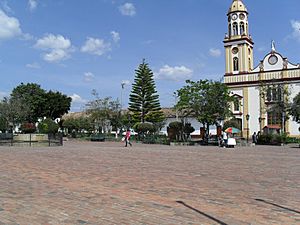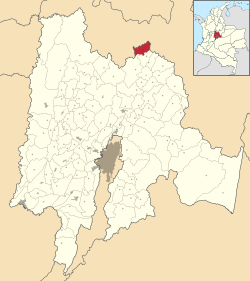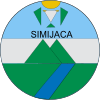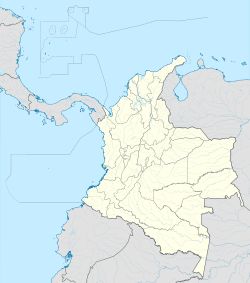Simijaca facts for kids
Quick facts for kids
Simijaca
|
|||
|---|---|---|---|
|
Municipality and town
|
|||

Central square of Simijaca
|
|||
|
|||

Location of the municipality and town inside Cundinamarca Department of Colombia
|
|||
| Country | |||
| Department | |||
| Province | Ubaté Province | ||
| Founded | 14 August 1600 | ||
| Founded by | Luis Enríquez & Juan López de Linares | ||
| Area | |||
| • Municipality and town | 107 km2 (41 sq mi) | ||
| • Urban | 0.8 km2 (0.3 sq mi) | ||
| Elevation | 2,559 m (8,396 ft) | ||
| Population
(2015)
|
|||
| • Municipality and town | 13,077 | ||
| • Density | 122.2/km2 (316.5/sq mi) | ||
| • Urban | 7,293 | ||
| Time zone | UTC-5 (Colombia Standard Time) | ||
| Website | Official website: http://www.simijaca-cundinamarca.gov.co/ | ||
Simijaca is a town and municipality in Colombia. It is located in the Ubaté Province, which is part of the Cundinamarca Department.
The town center of Simijaca sits high up in the mountains. It is about 2,559 meters (8,396 feet) above sea level. This area is known as the Altiplano Cundiboyacense, a high plateau. Simijaca is about 136 kilometers (85 miles) away from Bogotá, the capital city.
Simijaca shares its borders with several other places. To the north, it borders Chiquinquirá and Caldas in the Boyacá Department. To the south, it borders Susa and Carmen de Carupa. To the west, it borders Caldas, and to the east, it borders San Miguel de Sema.
Contents
What Does Simijaca Mean?
The name Simijaca comes from the Chibcha language. This was the language of the Muisca people, who lived in this area long ago.
In their language, Simijaca means "Blue sky" and "Nose of the white owl."
A Look Back at Simijaca's History
Before the Spanish arrived, the area where Simijaca is now was home to the Muisca people. It was part of their large group of communities called the Muisca Confederation.
At first, Simijaca was loyal to the zaque, who was the leader of Hunza. But around the year 1490, the zipa (another Muisca leader) named Saguamanchica took control of Simijaca.
The first time the Spanish tried to set up a town here was on February 26, 1586. This attempt did not last very long. When a Spanish judge, Luis Enrique, visited in July 1600, the local people had not settled in the town. Also, the church that was supposed to be built was not ready.
So, on August 14, 1600, a new and permanent town of Simijaca was officially started. This happened in Cucunubá, and it was done by Luis Enríquez and Juan López de Linares. The new town was formed by indigenous people from Simijaca, Fúquene, and Nemoguá.
How Simijaca Makes Money
The main way people in Simijaca earn a living is through agriculture, which means farming. They grow many different crops.
Some of the most important farm products include:
They also produce a lot of milk.
Staying Connected in Simijaca
Simijaca has its own local TV station called ACOTV. You can watch it through analogue cable.
The local high school, IED Agustín Parra, also has its own FM radio station. You can find it on 97.7 MHz. It's even available to listen to online!
Images for kids
See also
 In Spanish: Simijaca para niños
In Spanish: Simijaca para niños






